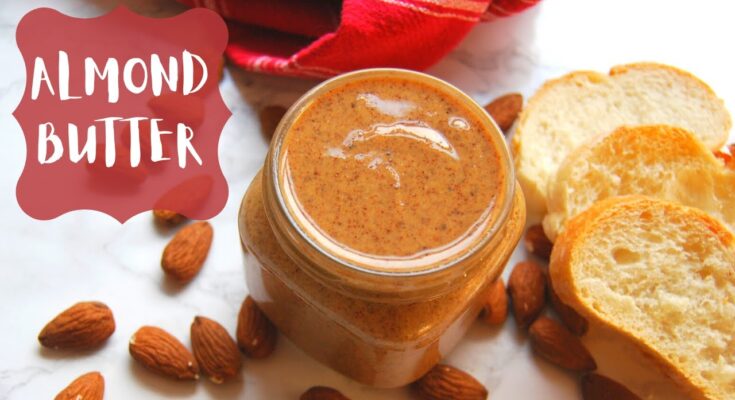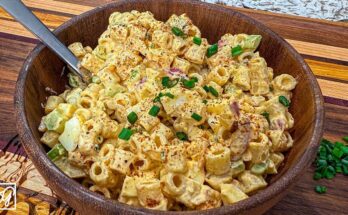Almond Butter Recipe: Almond butter is one of those delicious, nutrient-packed spreads that feels indulgent but is actually good for you. If you’ve only ever tasted the store-bought variety, you’re in for a treat. Making almond butter at home isn’t just a fun kitchen project—it’s healthier, fresher, and often more affordable than buying a jar from the store.
So, why make almond butter yourself? For starters, you have full control over what goes in. That means no unnecessary sugar, preservatives, or oils—unless you want them. Plus, you can tweak the texture, saltiness, and sweetness to your exact preference.
And let’s not overlook the health perks. Almond butter is rich in healthy fats, protein, fiber, and essential vitamins like vitamin E and magnesium. It’s an energy-boosting, heart-healthy spread that works well on toast, in smoothies, or even eaten by the spoonful.
Ingredients You’ll Need
Creating creamy, dreamy almond butter starts with quality ingredients. And the best part? You don’t need a long list. Just a handful of simple items can lead to a jar full of nutty goodness.
Here’s what you’ll need:
- Raw Almonds – 2 to 3 cups, depending on your blender size.
- Salt (optional) – Just a pinch to enhance the flavor.
- Honey or Maple Syrup (optional) – For a hint of sweetness.
- Neutral Oil (optional) – Such as avocado or sunflower oil, only if needed for creaminess.
When picking almonds, opt for fresh, high-quality raw almonds. Organic, non-GMO almonds are ideal if you’re aiming for a clean, wholesome butter. Avoid pre-roasted or salted almonds—they often come with added oils and flavors that can mess with your end result.
Want a crunchy texture? Add a handful of chopped almonds toward the end of blending. Want it sweeter or spicier? Consider cinnamon, vanilla extract, or even cocoa powder for a twist.
Equipment Required
Making almond butter isn’t rocket science, but using the right equipment can make or break your success. Here’s what you’ll need:
- High-Speed Blender or Food Processor: This is the heart of the operation. Brands like Vitamix, Ninja, or Cuisinart work well. A powerful motor is crucial for breaking down almonds into a smooth paste.
- Baking Sheet: For roasting the almonds evenly.
- Spatula: You’ll need this to scrape down the sides of your blender frequently.
- Glass Jar or Airtight Container: For storing your finished butter.
Pro tip: If your blender gets hot quickly, take breaks during blending. It protects your equipment and prevents overheating the almonds, which can affect the flavor.
Step-by-Step Almond Butter Recipe
Now, let’s dive into the actual process. Making almond butter is easy if you follow these detailed steps.
Step 1: Roast the Almonds
Start by preheating your oven to 350°F (175°C). Spread the raw almonds in a single layer on a baking sheet. Roast for 10 to 12 minutes, stirring once halfway through. You’ll know they’re ready when they smell fragrant and look slightly darker.
Roasting is optional, but it enhances the natural oils and deepens the nutty flavor—plus it makes the blending process faster. Just don’t skip this step if you want ultra-creamy almond butter.
Step 2: Cool and Prepare the Almonds
Once roasted, allow the almonds to cool for 10-15 minutes. This is key. Hot almonds can trap steam, which might make your butter too thick or cause moisture issues later.
After cooling, transfer them to your blender or food processor. Avoid crowding; if you’re making a large batch, work in portions.
Step 3: Blend the Almonds
Now the real magic begins. Start blending the almonds on low and gradually increase the speed. Initially, you’ll see a coarse meal. Then it’ll clump into a dough-like ball. Keep going.
After about 10-15 minutes (yes, be patient), the oils will release, and you’ll get that smooth, spreadable almond butter texture. Scrape down the sides as needed and take breaks if your machine starts to heat up.
Step 4: Customize Your Butter
At this point, your almond butter is smooth and creamy. Time to customize! Add a pinch of salt for flavor balance. Want it sweet? Try a tablespoon of honey or maple syrup. Prefer a nutty punch? Toss in a few roasted almond chunks for crunch.
You can also go bold: cinnamon, vanilla, or a dash of cayenne for a spicy kick. Blend in your add-ins for just a few seconds to keep the texture nice.
Step 5: Store and Serve
Transfer your almond butter to a clean glass jar or airtight container. Store it in the refrigerator for up to 3 weeks. Always use a clean spoon to avoid contamination.
Enjoy it on toast, in smoothies, drizzled over oatmeal, or by the spoonful. You’ve earned it!
Tips for Perfect Almond Butter Every Time
Making almond butter might seem easy, but there are a few insider secrets that can elevate your spread from good to gourmet. Whether you’re a first-timer or a seasoned nut-butter lover, these tips will help you get that dreamy, creamy consistency every single time.
1. Be Patient During Blending: This is where most people give up too soon. The almonds go through several stages: meal, dough ball, gritty paste, and finally a smooth, oily butter. Each stage requires time. So resist the urge to add oil early—just keep blending. Your machine will heat the almonds, which helps release the natural oils.
2. Roast for Richness: Roasting your almonds is like unlocking a treasure chest of flavor. It not only makes the butter tastier but also helps the nuts break down faster. Make sure to roast until just golden and aromatic—burnt almonds will make your butter bitter.
3. Don’t Overdo the Add-ins: A little goes a long way. If you want sweet or flavored almond butter, add things slowly and taste as you go. Too much sweetener or oil can throw off the consistency and flavor balance.
4. Use a Heavy-Duty Machine: Weak blenders will struggle and may even burn out. A high-powered food processor or blender like a Vitamix or Breville is ideal. If your machine starts overheating, give it a break—pushing it too hard could cause damage.
5. Store It Right: Always store almond butter in a clean, airtight container. Refrigeration helps extend the shelf life and keeps the oils from separating too quickly. Stir before each use to maintain consistency.
Common Mistakes to Avoid:
- Using cold almonds: Warmed or roasted nuts blend better and faster.
- Adding water: Never use water to loosen the butter. It encourages spoilage and alters texture.
- Not scraping down the sides: You’ll waste a lot of almonds if you don’t regularly push them back into the blades.
Flavor Variations to Try:
- Chocolate Almond Butter: Add cocoa powder and maple syrup.
- Vanilla Cinnamon: A splash of vanilla extract and a pinch of cinnamon.
- Spicy Almond Butter: Try a tiny pinch of cayenne or chili flakes.
Nutritional Value of Almond Butter
Almond butter isn’t just a tasty treat—it’s a nutritional powerhouse. Whether you’re following a keto, vegan, paleo, or clean-eating lifestyle, it fits in beautifully.
Here’s a breakdown of what one tablespoon (about 16g) of almond butter typically contains:
| Nutrient | Amount |
|---|---|
| Calories | 98-102 |
| Protein | 3.4g |
| Fat | 9g (mostly unsaturated) |
| Carbohydrates | 3g |
| Fiber | 1.6g |
| Sugar | 0.5g (natural) |
| Vitamin E | 25% DV |
| Magnesium | 13% DV |
Why it’s good for you:
- Heart Health: High in monounsaturated fats that help reduce bad cholesterol.
- Muscle Building: A solid source of plant-based protein and magnesium.
- Blood Sugar Control: Low in carbs and high in healthy fats, helping to stabilize glucose levels.
- Antioxidants: Rich in Vitamin E, a powerful antioxidant that supports skin and immune health.
Whether you’re spreading it on toast, adding it to smoothies, or using it in baking, almond butter adds a nutritional kick to any meal.
FAQs about Almond Butter Recipe
1. Can I make almond butter without roasting the almonds?
Yes, but the result won’t be as flavorful or creamy. Roasting helps release natural oils and enhances taste. If you prefer raw almond butter, expect a slightly grittier texture.
2. How long does homemade almond butter last?
Stored in an airtight container in the refrigerator, it lasts about 2 to 3 weeks. You can also freeze it for up to 3 months. Always use a clean spoon to avoid contamination.
3. Can I use other nuts in this recipe?
Absolutely! Cashews, peanuts, pecans, and hazelnuts all work well. You can also mix them for a custom blend. Just follow the same roasting and blending steps.
4. Is almond butter good for weight loss?
Yes, in moderation. It’s high in healthy fats and protein, which help keep you full. Just be mindful of portion sizes—it’s calorie-dense.
5. Why is my almond butter dry?
This often happens if the almonds weren’t roasted long enough or your blender isn’t strong enough. Keep blending, or add a teaspoon of neutral oil to help it along.
Conclusion
Making almond butter at home is one of those rewarding kitchen projects that not only saves you money but also gives you something better than store-bought. You get to skip the preservatives, adjust the flavor to your liking, and indulge in a fresh, creamy spread that’s packed with nutrients.
From choosing quality almonds and roasting them just right to blending with patience and customizing with fun add-ins—every step matters. But it’s worth every minute when you scoop out that velvety, golden butter and spread it on your favorite toast.
Once you make it yourself, you’ll never want to go back to the store version. Go ahead—get your almonds ready, turn on that blender, and let’s get nutty!



